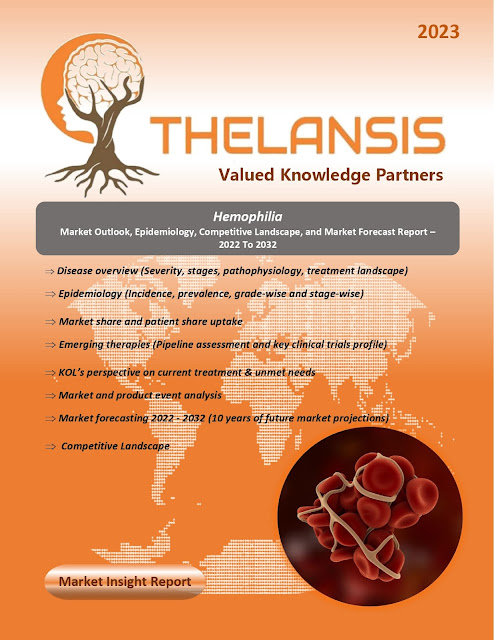Hemophilia – Market Outlook, Epidemiology, Competitive Landscape, and Market Forecast Report – 2022 To 2032
Hemophilia is a severe hereditary
hemorrhagic disorder, with significant types of haemophilia A (also known as
classic haemophilia or factor VIII deficiency) and haemophilia B (also known as
Christmas disease or factor IX deficiency). The disorder is inherited and is
characterized by a deficiency of clotting factors in the blood. Hemophilia C is
a rare condition caused by a deficiency of clotting factor XI. Approximately
25% of haemophilia A cases are caused by gross gene rearrangements, with 5% due
to gross gene deletions and 20% to inversions of a 500-600 kb segment that
breaks intron 22 of the F8 gene. Hemophilia B cases due to gross rearrangements
of F9 are less than 2%. F9 mutations occur more frequently in male germline
than in female germline. Hemophilia can manifest in mild, moderate, and severe
forms, depending on the blood level or amount of clotting factor and the
patient's symptoms. Mild haemophilia involves having 6-49% of the normal factor
level, with bleeding typically occurring only after a significant injury,
trauma, or surgery. Moderate haemophilia is characterized by having 1-5% of the
normal factor level, with bleeding episodes, typically following injuries,
major trauma, or surgery. Patients with moderate haemophilia may also experience
occasional spontaneous bleeding episodes without an obvious cause. Differential
diagnosis is required to exclude other conditions presenting with similar
symptoms, such as von Willebrand disease, scurvy, diseases of platelet
dysfunction, and deficiencies of other coagulation factors.
·
In the United States, the estimated prevalence
of haemophilia is 12 cases per 100,000 U.S. males for haemophilia A and 3.7
cases per 100,000 U.S. males for haemophilia B.
Thelansis’s “Hemophilia Market
Outlook, Epidemiology, Competitive Landscape, and Market Forecast Report – 2022
To 2032" covers disease overview, epidemiology, drug utilization,
prescription share analysis, competitive landscape, clinical practice,
regulatory landscape, patient share, market uptake, market forecast, and key
market insights under the potential Hemophilia treatment modalities options for
eight major markets (USA, Germany, France, Italy, Spain, UK, Japan, and China).
KOLs insights
of Hemophilia across 8 MM market from the centre of Excellence/ Public/ Private
hospitals participated in the study. Insights around current treatment
landscape, epidemiology, clinical characteristics, future treatment paradigm,
and Unmet needs.
Hemophilia Market Forecast Patient
Based Forecast Model (MS. Excel Based Automated Dashboard), which Data Inputs
with sourcing, Market Event, and Product Event, Country specific Forecast
Model, Market uptake and patient share uptake, Attribute Analysis, Analog
Analysis, Disease burden, and pricing scenario, Summary, and Insights.
Thelansis Competitive Intelligence (CI) practice
has been established based on a deep understanding of the pharma/biotech
business environment to provide an optimized support system to all levels of
the decision-making process. It enables business leaders in forward-thinking
and proactive decision-making. Thelansis supports scientific and commercial
teams in seamless CI support by creating an AI/ ML-based technology-driven
platform that manages the data flow from primary and secondary sources.




Comments
Post a Comment